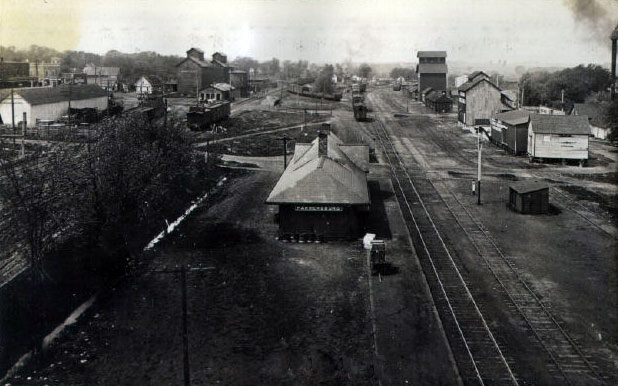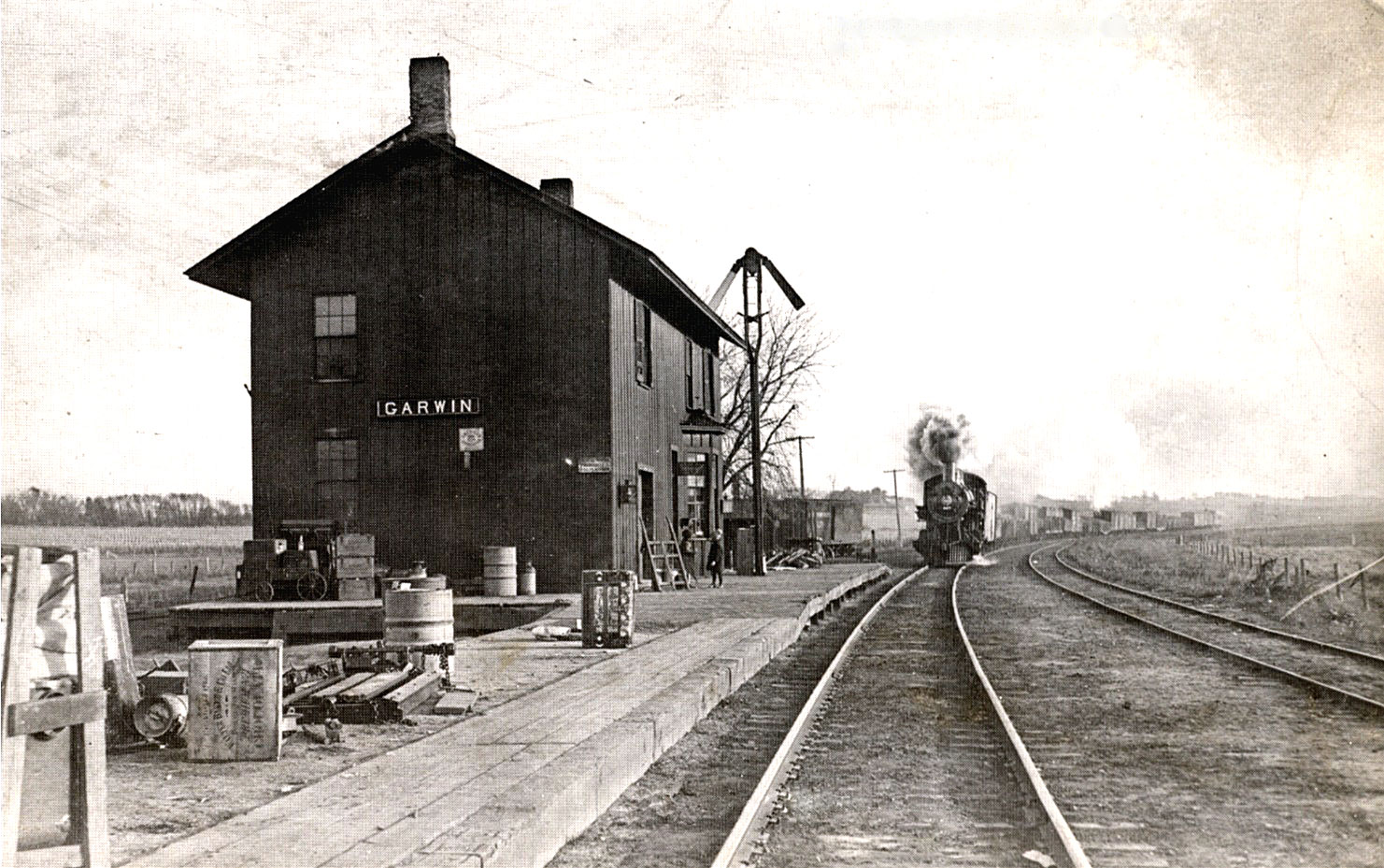|
My Dad,
Ernest Koehn, was a traveling mechanic for the Chicago & North Western
Ry. He and one other man, Oscar
Mellgren, were assigned all the territory in Iowa
pretty much north of the C&NW east-west main lines and up into southern Minnesota. Mr. Mellgren’s father, incidentally,
was also a C&NW Traveling Mechanic dating that family’s service
back to the 1890’s. Eagle Grove
was sort of in the middle of this territory.
They had a nice sized shop in one section of the Eagle Grove
roundhouse, separate and secured off from the main part of the
roundhouse. He also had a panel truck
in addition to his Fairmont Motor Car.
His territory is highlighted on the map further down the page. Truman’s article on track motor cars
can be found here along with a picture of Ernest Koehn..
Traveling
mechanics kept coal chutes working, water tanks functioning and did all the
plumbing, heating and air conditioning (if there was any air conditioning) in
all the buildings owned by the C&NW including the depots. There were a
great number of depots in those days.
My Dad's
territory out of Eagle Grove included the line west of Eagle Grove to Hawarden,
IA on the South
Dakota state line.
This line went through Orange City, Iowa.
(Holland Dutch settlements). He also
covered the territory from Eagle Grove north to Fox Lake, MN, which included most of the
southern Minnesota lines through Blue Earth, Fairmont and Butterfield as well
as Bricelyn to Mason City, and continuing south down to Belle Plaine on the
main line via Parkersburg. He had the
rural east - west cross line from Wall
Lake through Jewell and over to
Tama, on the main line. The Iowa
Falls-Alden Line and the Eagle Grove line south down to Ames,
which is also on the main line. On the
line north of Eagle Grove, at one time that line split at Burt so the line to
the left that went though Ringsted and Dolliver (Danish settlements) was
called the Burt line. The line that
went straight north to Blue Earth went via Elmore and was called the Elmore
Line. Almost all of these lines are
gone today so you would need an old C&NW system map to follow up on most
of my Dad's territory, (see below). He
was on the road a great deal and was a monthly employee with an expense
account. He knew most of the hotels in
northern Iowa and southern Minnesota
very well. My Dad even worked as far
north in Minnesota as St. James
and Butterfield.
Lots of
cattle were shipped on the railroads in those days and many stations all
along the branch lines in the rural areas had stock yards. I remember they had to keep the stock yards
functioning for water and such. Cattle
were either gathered up and shipped from these stock yards or in some cases,
cattle had to be unloaded, fed and watered after so many hours in stock
cars. Stockmen rode in the cabooses to
insure the livestock were cared for while being shipped. There were also large 4 inch diameter
"stand pipes," which operated at two levels along the tracks every
so many miles in larger communities.
These were used to spray water on hogs being shipped in stock cars,
which had 2 levels. Hogs do not sweat
and will die in the famous Iowa
hot summer weather if not watered down every so many miles. (Bet you did not know that - and few
remember this today.) The 4 inch pipes
were flared or nearly flattened on the ends to provide a good solid spray
across the stock cars. Behind these
"stand pipes" a man would operate these big flared pipes up and
down on pivots as the train moved past very slowly. They used a lot of water under high
pressure soaking down the hogs.
My Dad
also did lots of welding and did steam pressure welding up to around 200
pounds that I know about. He was also
a qualified pipe fitter and had done pipe fitting in roundhouses at one time. He also took care of wind mills that
pumped water into tanks on branch lines out in the middle of "no
where" for the needs of an occasional steam powered train. I recall he climbed smoke stacks as my Dad
was sent out to Iowa to replace a man killed when the man slipped off near
the top of a smokestack, the rivets in his safely belt ripping out as
well. The C&NW put new rivets back
in and my Dad had that same safety belt for decades.
My Dad
grew up in Danville, IL,
home to the famous Oakland Shops of the Chicago & Eastern Illinois
Railroad. At one time, 1,500 men
worked in the Oakland Shops. My Dad
came out of a large railroad family, all of whom had at one time worked in
the Danville roundhouse or
shops. My Dad apprenticed as a sheet
metal worker and carried his union card as a sheet metal worker and was the
last card carrying union sheet metal worker employed on the C&NW north of
Chicago. My Dad came up to Fond
du Lac and hired on the C&NW around 1922 as the
C&NW was the only railroad in the nation that settled the Great 1922
National Shop Craft Railroad Strike.
(None of my Dad’s immediate family ever went back to work on the
C&EI at Danville as all of
the shop craft unions lost that strike, except on the C&NW.) This was the last national railroad strike
in American history. My Dad worked as
a sheet metal worker, pipe fitter and welder at North Fond du Lac
on the C&NW. I was born in Fond
du Lac.
Shortly before World War II began, my Dad was
“temporarily” sent back to Eagle Grove,
Iowa for 6 months to fill in after the
man previously mentioned was killed falling off a smoke stack. The war broke out, men became scarce, so my
Dad was “frozen” at Eagle Grove and the 6 months turned into 15
or 16 years. My parents eventually
sold their home in Fond du Lac
and bought another in Eagle Grove, Iowa,
which at one time was a major division point on the C&NW and headquarters
of the Northern Iowa Division. In the
1950's, the Iowa and Southern
Minnesota lines began to disappear and my Dad was given the choice
by the C&NW to return to Fond du Lac,
go into Chicago, or come to Green
Bay. He
decided to go to Green Bay as he
had never worked there. He had worked
in the C&NW California Avenue
coach yard in Chicago in the
1930's for a spell building coaches, I believe. His transfer back up to Wisconsin
was around 1956-57. I came home from
7th Army in 1957 to find my family preparing to leave for Wisconsin. They moved to Green
Bay in 1958 when my Dad was 60 years old. This move had to have been very difficult
for them as by this time they had roots in Eagle Grove. But, we had no other relatives in the state
of Iowa.
Shortly
after I came back from Germany
(1957), in 1958 my grandfather, John Koehn Sr., died in Danville,
Illinois. He was almost 95 and had enjoyed near
perfect health and a totally clear mind up until the very last days of his
life. He was still on strike against
the C&EI right up until the day he died.
None of my Dad's brothers ever went back to work on the C&EI and
my youngest uncle, who never had an opportunity to go to work on the C&EI
due to the 1922 strike, began the 2nd truck line in the City of Chicago. My uncle, who had the truck line, had contracts with Sears as
well as Armour & Swift transporting meat, etc. and trucked right up Illinois
Highway #1 back in the 20's, 30's, 40's and 50's, right next to the C&EI
main line south of Chicago. And his
truck line trucked all over the Midwest. He helped put the C&EI out of
business. Proving that what goes
around comes around and that it is a long road indeed that does not have a
turn in it.
|






